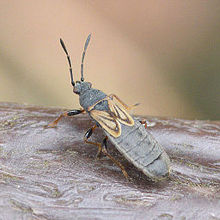Blissidae
| Blissidae | |
|---|---|

| |
| Ischnodemus sabuleti | |
| Scientific classification | |
| Kingdom: | Animalia |
| Phylum: | Arthropoda |
| Class: | Insecta |
| Order: | Hemiptera |
| Suborder: | Heteroptera |
| Infraorder: | Pentatomomorpha |
| Superfamily: | Lygaeoidea |
| Family: | Blissidae Stål, 1862[1] |
The Blissidae are a family in the Hemiptera (true bugs), comprising nearly 50 genera and 400 species.[2] The group has often been treated as a subfamily of the Lygaeidae but was resurrected as a full family by Thomas Henry (1997).[3]
The adult insects are elongate, typically four times as long as broad, and in some species, up to seven times. Short-winged forms are common in many species.
All the species feed on the sap of plants, mostly grasses, and most of the species live between the sheaths of leaves.[2] The most economically important species is the true chinch bug, Blissus leucopterus, a destructive pest of corn crops in the United States.
List of genera[]
These 54 genera of the family Blissidae are listed in the Lygaeoidea Species File:[4][2]
- Slater & Wilcox, 1969
- Slater, 1967
- Slater, 1986
- Slater, 1967
- Slater, 1986[5]
- Slater & Sweet, 1963
- Slater, 1967
- Brailovsky, 2015
- Slater, 1967
- Blissus Burmeister, 1835 (chinch bugs)
- Stal, 1861
- Slater & Sweet, 1972
- Distant, 1903
- Slater & Wilcox, 1968
- Spinola, 1839
- Slater, 1961
- Stal, 1872
- Slater & Wilcox, 1966
- Slater, Ashlock & Wilcox, 1969
- Slater & Wilcox, 1969
- Ghauri, 1982
- Distant, 1901
- Barber, 1954
- Stys, 1991[6]
- Distant, 1904
- Horvath, 1892
- Ischnodemus Fieber, 1837
- Slater, 1967
- Slater, 1968
- Slater & Wilcox, 1973
- Motschulsky, 1859
- Slater, 1967
- Slater, 1967
- Brailovsky & Barrera, 2012[7]
- Slater & Ahmad, 1971
- Distant, 1901
- Distant, 1904
- Barber, 1949
- Slater, 1966
- Slater & Wilcox, 1966
- Slater, 1986
- Slater, 1979
- Slater, 1967
- Slater & Wilcox, 1966
- Kormilev, 1949
- Slater & Wilcox, 1969
- Slater, 1968
- Drake & Davis, 1959
- Stal, 1874
- Slater & Wilcox, 1973
- Toonglasa Distant, 1893[8]
- Dellapé & Minghetti, 2020
- Henry & Sweet, 2015
- Barber, 1954
References[]
| Wikimedia Commons has media related to Blissidae. |
| Wikispecies has information related to Blissidae. |
- ^ Stål, C. (1862). "Synopsis Coreidum et Lygaeidum Sueciae". Öfversigt Af Kongliga Vetenskaps-Akademiens Förhandlingar. 19. p. 212.
- ^ a b c Slater, J.A. (1979). "The systematics, phylogeny, and zoogeography of the Blissinae of the world (Hemiptera, Lygaeidae)". Bulletin of the AMNH. 165 (1): 1–180. hdl:2246/1076.
- ^ Henry, T.J. (1997). "Phylogenetic analysis of family groups within the infraorder Pentatomomorpha (Hemiptera: Heteroptera), with emphasis on the Lygaeoidea". Annals of the Entomological Society of America. 90 (3): 275–301. doi:10.1093/aesa/90.3.275.
- ^ Dellapé, Pablo M.; Henry, Thomas J. (2021). "family Blissidae Stål, 1862". Lygaeoidea Species File. Retrieved 2021-10-04.
- ^ Slater, J.A. (1986). "Aulacoblissus, a New Genus of Micropterous Blissinae from Venezuela (Hemiptera: Lygaeidae)". Florida Entomologist. 69 (4): 661–665. doi:10.2307/3495210. JSTOR 3495210.
- ^ Štys, P. (1991). "First apterous genus and species of Lygaeidae: Blissinae (Heteroptera)". Acta Entomologica Bohemoslovaca. 88 (3–4): 265–271.
- ^ Brailovsky, H.; Barrera, E. (2012). "A remarkable new Micropterous Blissidae (Hemiptera, Heteroptera, Lygaeoidea) from South America". Deutsche Entomologische Zeitschrift. 59 (1): 43–45.
- ^ Slater, J.A.; Brailovsky, H. (1983). "Review of the Neotropical Genus Toonglasa (Hemiptera, Lygaeidae)" (PDF). Annals of the Entomological Society of America. 76 (3): 523–535. doi:10.1093/aesa/76.3.523. Archived from the original (PDF) on 2014-12-22. Retrieved 2014-12-16.
Categories:
- Blissidae
- Heteroptera families
- Pentatomomorpha stubs